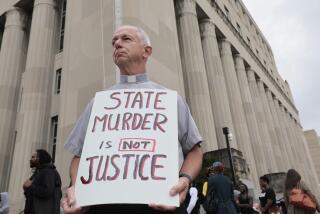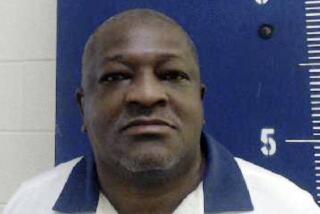High Court Lets Death Sentence Stand
WASHINGTON — A divided Supreme Court refused Monday to overturn the death sentence of a brutal Virginia murderer, even though his sentencing hearing was clearly flawed.
The case of Bobby Lee Ramdass is not one of an innocent man on death row. Rather, it illustrates the difficulty of achieving both a fair process and a fair result in capital cases. The ruling comes amid heightened scrutiny of administration of the death penalty.
A report released Monday found that more than two-thirds of death sentences from 1973 to 1995 were reversed on appeal. And the governor of Illinois has halted executions there for fear that an innocent person might be put to death.
But no one suggested Ramdass was innocent, and by most standards he looked to be the kind of killer who deserved the death penalty if anyone does.
In 1992, he was released from prison after serving four years for armed robbery. In short order, he murdered a man in Alexandria, Va., robbed a Pizza Hut restaurant and abducted one worker, robbed and beat a hotel employee and robbed a taxi driver and shot him in the head.
After midnight on Sept. 2, 1992, he entered a convenience store in Fairfax, Va., and ordered the clerk to open a safe. When the clerk fumbled with the lock, Ramdass put the gun to his head and killed him. Then he stood and laughed about the crime. His several crimes came before juries, which found him guilty. After he pleaded guilty to the murder in Alexandria and the shooting of the cabdriver, a jury was asked to decide whether to sentence Ramdass to death for the murder of the convenience store clerk.
His lawyer urged mercy and said that his client “will never see the light of day” outside of prison. The prosecutor urged a death sentence and called Ramdass a dangerous, callous killer.
During deliberations, the jurors asked whether Ramdass might ever be paroled. Rather than answer directly, the judge told the jury to focus on the proper punishment for the crime.
The next day, the jury recommended a death sentence.
A year later, the Supreme Court ruled in a South Carolina case that jurors must be told the truth about whether a defendant may be paroled. Because the phrase “a life sentence” did not always mean that a murderer would stay in prison for life, some jurors might think that they must impose a death sentence to protect society.
The 1994 ruling in Simmons vs. South Carolina put sentencing judges on notice that they must tell jurors whether a defendant might be paroled in the future.
On Monday, the court, by a 5-4 vote, refused to apply that rule retroactively to reverse Ramdass’ death sentence, which was imposed in 1993. Writing for the court, Justice Anthony M. Kennedy pointed out that Ramdass was technically eligible for parole during the 1993 sentencing hearing because he had not been sentenced for all the various crimes he had committed.
Chief Justice William H. Rehnquist and Justices Antonin Scalia and Clarence Thomas joined in rejecting the inmate’s claim in the case (Ramdass vs. Angelone, 99-7000). Justice Sandra Day O’Connor agreed in a separate opinion.
The dissenters called it a case of “acute unfairness.” They said that prosecutors were allowed to argue that Ramdass presented a danger to society, even though they knew he would never leave prison.
“This is a simple case. Why does the Court insist that the Constitution permits the wool to be pulled over the [jurors’] eyes,” asked Justice John Paul Stevens. Justices David H. Souter, Ruth Bader Ginsburg and Stephen G. Breyer agreed that Ramdass deserved a new sentencing hearing.
More to Read
Sign up for Essential California
The most important California stories and recommendations in your inbox every morning.
You may occasionally receive promotional content from the Los Angeles Times.











